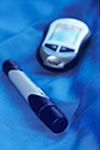
 Diabetes Prevention
Diabetes Prevention
Due to the fact that Type 1 diabetes is an autoimmune disease, not much can be done in terms of prevention. However, Type 2 diabetes can be prevented by making the following healthy lifestyle choices:
- Healthy eating: The diabetes food pyramid proposed by the American Diabetes Association offers the group and amount of food recommended. It includes valuable tips for breads, grains and other starches that contain mostly carbohydrates, vegetables and fruits, non fat dairy products, proteins like meat or substitutes and very small servings of fats, oil and sweets.
- Exercise: Exercising regularly not only helps control blood sugar levels, it also increases levels of good cholesterol and burns excess calories and fat so you may achieve optimal weight. Daily activities may include walking, dancing, biking, gardening, and washing your car for at least 30 minutes each day.
- Monitor your blood pressure & Quit smoking: Controlling blood pressure levels and quitting smoking are similarly effective measures. High blood pressure levels and nicotine may not cause symptoms but over time damage the heart, kidneys and nerves.
- Blood sugar level: Always monitor your blood sugar levels before and after meals according to your doctor’s instructions to prevent drastic fluctuations in blood sugar levels.
- Foot and skin care: Always wear comfortable shoes and pay attention to any irritations in your skin.
- Gather support: If you are at risk for developing Diabetes Mellitus Type 2, share your feelings and challenges with family members, friends and Diabetes support groups to help guide you in preventing the disease.
Keep in mind that everyday is a new day and a new opportunity to take care of you. Living with diabetes is a daily challenge and meeting the challenge starts with learning about it and knowing what you can do to stay healthy and feel better.
Treatment for Diabetes Type 1 & 2
The overall goal in the treatment of diabetes is to manage any elevation of blood glucose (hyperglycemia) without causing abnormally low levels of blood sugar. Type 1 diabetes is usually treated with insulin, physical activity, and a diabetic diet. This is in contrast with Type 2 diabetes where the disease is treated first via weight reduction, diet, and physical activity. If these actions fail to control hyperglycemia, then oral medications are used. If the oral medications provide unsatisfactory results, then treatment with insulin is considered.
Insulin now comes in a variety of preparations that differ in the amount of time following injection until they begin to work and the duration of their action. The different types of insulin (rapid-acting, short-acting, and long-acting) each aim to keep the blood sugar in target range throughout the day. Due to these differences, combinations of insulin are used to allow for a customized routine of blood sugar control. The table below illustrates the most common types of insulin currently in use in the U.S. and their specific properties.
| Name of Insulin | Onset of Action | Peak Effect After Injection |
| Humalog and Novolog//Very Short Acting | 5–15 minutes | 30–60 minutes |
| Regular/Short Acting | 30 minutes | 2–5 hours |
| NPH/Intermediate Acting | 1–2.5 hours | 8–14 hours |
| Lente/Intermediate Acting | 1–2.5 hours | 8–12 hours |
| Ultra Lente/Long Acting | 4–6 hours | 10–18 hours |
| Lantus | 2–3 hours | Stable from 2–3 hours to @20 hours |
| Detemir | 3–4 hours | Dose dependent (longer acting at higher doses) |
| Combinations – 75/25, 70/30, 50/50 | 30 minutes | 7–12 hours |
For example, a patient may take an injection of Humalog just before meals to cover the increase in carbohydrate load after eating.
In general, the frequency of administration consists of multiple daily insulin injections or through a portable pump delivering a continuous subcutaneous infusion. The doses are timed to reproduce normal patterns of basal insulin secretion.
However, insulin therapy requires frequent monitoring through self-management of blood glucose levels. Intensive control targeting normoglycemic preprandial (before a meal) and postprandial blood glucose levels reduces the risk of developing microvascular complications, but may be associated with more frequent episodes of hypoglycemia.
Insulin regimens used to treat type 1 diabetes
Two daily injections: Comprised of (1) intermediate-acting insulin mixed with a rapid-acting insulin analog (or short acting insulin) before breakfast; and (2) intermediate-acting insulin mixed with a rapid-acting insulin analog insulin (or short-acting insulin) before dinner. Often started by administering 2/3 of the estimated daily dose before breakfast and 1/3 before dinner.
Three daily injections: Comprised of (1) intermediate-acting insulin mixed with a rapid-acting insulin analog (or short-acting insulin) before breakfast; (2) a rapid acting insulin analog (or short-acting insulin) before dinner; and (3) intermediate-acting insulin at bedtime. May reduce the frequency and severity of overnight hypoglycemia.
Four daily injections: Comprised of (1-3) a rapid-acting insulin analog (or short-acting insulin) before breakfast, lunch and dinner; and (4) a long-acting insulin analog (or intermediate-acting insulin) at bedtime.
Type 2 Diabetes Mellitus -Treatment
The first line treatment for mild to moderate hyperglycemia is oral hypoglycemics such as sulfaonylureas, Metformin, and Thiazolidinediones which increase tissue sensitivity to insulin. These oral medications are combined with lifestyle modifications of the patient. Lifestyle modifications such as dietary changes, weight reduction, smoking cessation, moderation of alcohol intake, and increased physical activities are highly recommended. However, the specific regimen of care can be slightly different depending on the conditions of the patient.